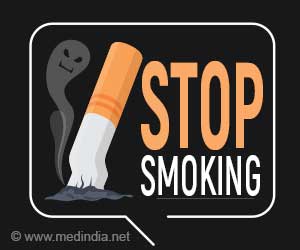Cigarette smoking doubled the risk of heart failure and elevated risk persisted for decades after people quit smoking.

‘Cigarette smoking doubled the risk of heart failure and elevated risk persisted for decades after people stopped smoking.’





The study is thought to be one of the first to assess smoking’s association with both heart failure subtypes: reduced ejection fraction and preserved ejection fraction.For their study, the researchers analyzed records from a long-running study of nearly 9,500 individuals in four U.S. communities. The study found that participants who had stopped smoking retained a significantly increased risk of either type of heart failure for decades after they had stopped smoking.
The study was published online in the Journal of the American College of Cardiology. “These findings underline the importance of preventing smoking in the first place, especially among children and young adults,” says study senior author Kunihiro Matsushita, MD, PhD, an associate professor in the Bloomberg School’s Department of Epidemiology. “We hope our results will encourage current smokers to quit sooner rather than later since the harm of smoking can last for as many as three decades.”
Link Between Smoking and Heart Failure
Heart failure is a progressive condition in which the heart loses its ability to pump enough blood to meet the body’s needs. It’s one of the most common causes of disability and death in developed countries with more than 6 million adults living with heart failure in the U.S. alone according to the Centers for Disease Control and Prevention’s most recent data.Besides cigarette smoking, risk factors for heart failure include obesity, hypertension, diabetes, coronary artery disease and advanced age.
There are two types of heart failure: reduced ejection fraction and preserved ejection fraction. In heart failure with reduced ejection fraction, the left ventricle — the principal cardiac pump — fails to contract sufficiently when pumping blood outward. Heart failure with reduced ejection fraction is more closely tied to coronary artery disease. Treatment includes several medications that improve prognosis.
Advertisement
Matsushita and colleagues evaluated health records of participants in Atherosclerosis Risk In Communities (ARIC) study. Launched in 1987, the ARIC study includes middle-aged and older adults across the U.S., with a substantial representation of Black individuals. The new study’s analysis included data from four communities in Maryland, North Carolina, Minnesota and Mississippi and focused on 9,345 ARIC participants, ages 61 to 81, who had sufficient records and no diagnosis of heart failure as of the start of 2005.
The link with smoking also showed a “dose-response” relationship — more cigarettes per day and more years of smoking being associated with higher heart failure risk. Similarly, quitting smoking brought a drop in heart failure risk that increased over time. Overall, former smokers were 31 percent and 36 percent more likely to have preserved ejection fraction and reduced ejection fraction, respectively, compared to never-smokers.
When the researchers stratified former smokers by number of years since quitting, they found that their overall heart failure risk remained significantly higher than never-smokers’ risk — except for the group that hadn’t smoked for 30 years or more.
“This reinforces the view that smoking casts a long shadow over heart health,” Matsushita says.
The original article was co-authored by Ning Ding, Amil Shah, Michael Blaha, Patricia Chang, Wayne Rosamond, and Kunihiro Matsushita.
Source-Eurekalert















